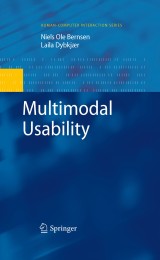Details

Multimodal Usability
Human-Computer Interaction Series
|
149,79 € |
|
| Verlag: | Springer |
| Format: | |
| Veröffentl.: | 03.10.2009 |
| ISBN/EAN: | 9781848825536 |
| Sprache: | englisch |
| Anzahl Seiten: | 431 |
Dieses eBook enthält ein Wasserzeichen.
Beschreibungen
This preface tells the story of how Multimodal Usability responds to a special challenge. Chapter 1 describes the goals and structure of this book. The idea of describing how to make multimodal computer systems usable arose in the European Network of Excellence SIMILAR – “Taskforce for cre- ing human-machine interfaces SIMILAR to human-human communication”, 2003– 2007, www. similar. cc. SIMILAR brought together people from multimodal signal processing and usability with the aim of creating enabling technologies for new kinds of multimodal systems and demonstrating results in research prototypes. Most of our colleagues in the network were, in fact, busy extracting features and guring out how to demonstrate progress in working interactive systems, while claiming not to have too much of a notion of usability in system development and evaluation. It was proposed that the authors support the usability of the many multimodal pro- types underway by researching and presenting a methodology for building usable multimodal systems. We accepted the challenge, rst and foremost, no doubt, because the formidable team spirit in SIMILAR could make people accept outrageous things. Second, h- ing worked for nearly two decades on making multimodal systems usable, we were curious – curious at the opportunity to try to understand what happens to traditional usability work, that is, work in human–computer interaction centred around tra- tional graphical user interfaces (GUIs), when systems become as multimodal and as advanced in other ways as those we build in research today.
Structure, Usability, Readership.- Intermezzo 1: Three Multimodal Cases.- Creating a Model of Use.- Modalities and Devices.- Intermezzo 2: Status on Cases and Next Steps.- Common Approaches, Methods, Planning.- Intermezzo 3: Case Usability Workplan, Design.- Question-Answering.- Meetings with Discussion.- Observation of Users.- Imagination.- Interaction with the System.- Lab Sessions with Subjects.- Intermezzo 4: Case Usability Method Plan.- Data Handling.- Usability Data Analysis and Evaluation.- Intermezzo 5: Sudoku Usability Evaluation.- Multimodal Usability: Conclusions and Future Work.
<P><EM>Multimodal Usability</EM> demonstrates several major generalisations of human-computer interaction and extends the traditional focus on graphical user interfaces to all input/output modalities accessible to vision, hearing, and touch.</P>
<P></P>
<P><EM>Multimodal Usability</EM> can help make a multimodal interactive system usable no matter if you are building a work tool or a game, and whether your system models aspects of people, like a virtual (or robot) companion or friend, or not.</P>
<P></P>
<P>Successful implementation can be achieved using the following usability development steps:</P>
<P></P>
<P>(1) Augment system model specification with an <EM>AMITUDE model of use</EM> specified in terms of Application type, Modalities, Interaction type, Task, User, Device and Environment of use.</P>
<P>(2) Apply <EM>usability methods</EM> to collect the <EM>usability data</EM> needed at any time. A toolbox of 24 key methods are presented in a common format. Methods are of five kinds: question-answering, meetings with discussion, observation, imagination, and interaction with the system.</P>
<P>(3) For each method application, <EM>post-process, annotate, analyse, report</EM>, and <EM>act on the data</EM> to improve system model usability.</P>
<P></P>
<P>Three multimodal system <EM>Cases</EM> are included to illustrate usability development from idea to user test of the implemented prototype.</P>
<P></P>
<P><EM>Multimodal Usability</EM> assumes no prior knowledge about usability and human-computer interaction.</P>
<P></P>
<P><EM>Multimodal Usability</EM> can help make a multimodal interactive system usable no matter if you are building a work tool or a game, and whether your system models aspects of people, like a virtual (or robot) companion or friend, or not.</P>
<P></P>
<P>Successful implementation can be achieved using the following usability development steps:</P>
<P></P>
<P>(1) Augment system model specification with an <EM>AMITUDE model of use</EM> specified in terms of Application type, Modalities, Interaction type, Task, User, Device and Environment of use.</P>
<P>(2) Apply <EM>usability methods</EM> to collect the <EM>usability data</EM> needed at any time. A toolbox of 24 key methods are presented in a common format. Methods are of five kinds: question-answering, meetings with discussion, observation, imagination, and interaction with the system.</P>
<P>(3) For each method application, <EM>post-process, annotate, analyse, report</EM>, and <EM>act on the data</EM> to improve system model usability.</P>
<P></P>
<P>Three multimodal system <EM>Cases</EM> are included to illustrate usability development from idea to user test of the implemented prototype.</P>
<P></P>
<P><EM>Multimodal Usability</EM> assumes no prior knowledge about usability and human-computer interaction.</P>
First to address interactive systems development and evaluation for usability from a thoroughly multimodal perspective First to argue that the field of human-computer interaction needs complete re-orientation to take into account the fact that GUI-based systems merely represent a single modality combination among thousands of others Presents a thorough introduction to modalities and multimodality The authors have a 16 year track record of usability-oriented research and development of novel, non-GUI-based systems, multimodal natural interactive systems, and modality theory

















